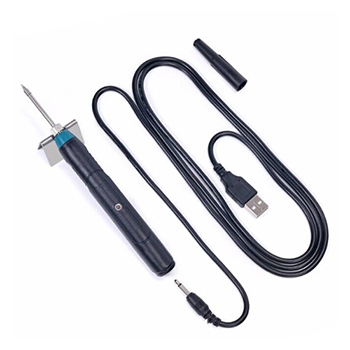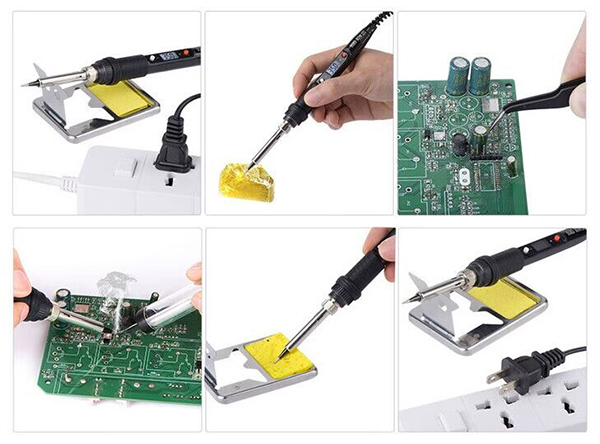How does Soldering Iron Work?
A soldering iron is an electrical tool used for welding various metals and stainless steel, and is widely used for welding household and industrial products as well as works of art. It is an increasingly popular power tool that saves labor and time. The working principle of a soldering iron can be simply summed up in two steps: power supply and heat conduction. Next, a detailed introduction to the working principle of the electric soldering iron.
Structure of soldering iron
An electric soldering iron is generally composed of a soldering iron tip, a soldering iron core, a casing, a handle, a power cord plug, and the like. The soldering iron tip is installed in the soldering iron core and is made of copper alloy material with a good thermal conductivity as the matrix. Its function is to store heat and conduct heat, and its temperature must be much higher than the temperature to be soldered.
Due to different purposes and mechanisms, there are various soldering irons.
From the heating method: there are direct heating types, induction types, gas combustion types, and so on.
From the heating capacity: 10W, 20W, 30W, 40W ... 300W, etc.
In terms of functions: there are single-purpose, dual-purpose, and temperature-regulating types.
The most commonly used is the direct heating type for single welding. It can be divided into two types: internal heat type and external heat type.
Working principle
The electric soldering iron is a very convenient tool for welding various metals. It works by converting electrical energy into welding heat and connecting metal materials through heat conduction.
The first step is power, which converts electricity into heat. In the soldering iron, the current enters the soldering iron from the plug, and then is converted into AC current through the power supply unit (transformer), then rotates through the soldering iron tip part (soldering needle), and finally forms a magnetic field. Its chemical action raises the temperature of the soldering pin, thereby generating thermal energy.
The second step is heat conduction, which converts thermal energy into welding heat. Most of the soldering iron head is made of metal, which is considering that it has good thermal conductivity, so the soldering iron tip can effectively transfer heat to the soldering pin, thereby generating enough welding heat. When the electrode contacts the soldering pin, the surface of the electrode melts due to the increase in temperature, effectively joining the metal materials.
During the soldering process, the temperature of the soldering iron can be adjusted through the adjustment button of the soldering iron, which can effectively control the temperature during the soldering process. In addition, during the welding process, the appropriate size of the soldering head should be selected according to the characteristics of the welding parts, and the welding time and welding speed should be adjusted to control the welding process to achieve the desired effect.
It can be seen from this that mastering the correct use of electric soldering iron plays a vital role in welding work.
How to use a soldering iron?
The electric soldering iron should be tinned before use. The specific method is:
Heat the electric portable soldering iron, and when the solder is melted, apply solder paste, and then apply solder evenly on the tip of the soldering iron, so that the tip of the soldering iron is evenly coated with a layer of tin.
Tin method on the wire head: tighten the wire head into a twist shape, and apply solder paste. Take a proper amount of solder with the tip of the soldering iron, touch the head of the wire, and rotate the wire. After the solder is completely melted and submerged into the head of the wire, lift the head of the wire slightly up and away from the tip of the soldering iron.
The welding method of the wire and the fork terminal: first tin the head of the wire, and then insert it into the tail tube of the fork terminal. Dip an appropriate amount of solder with the tip of the soldering iron and touch the solder joint.
After the solder on the solder joint is completely melted, gently lift the tip of the soldering iron along the terminal to leave the solder joint. The solder joint should be in the shape of a sine wave peak, the surface should be bright and smooth, without tin thorns and the amount of tin is moderate.
Pre-weld treatment
Before soldering, the component pins or the soldering parts of the circuit board should be soldered. Generally, there are three steps: "scraping", "plating" and "testing".
Scrape
"Scraping" is to clean the welding part before welding. The tools generally used are knives and fine sandpaper to clean the pins of integrated circuits and printed circuit boards, but the pins should be kept clean. For self-made printed circuit boards, the surface of the copper foil should be polished with fine sandpaper first, and the dirt on the printed circuit board should be cleaned, and then coated with rosin alcohol solution, flux or "HP-1" before use. For gold-plated silver alloy lead-out wires, the coating cannot be scraped off, and the surface dirt can be wiped off with an eraser.
Plating
"Plating" is tin plating on the scraped components. The specific method is to dip the rosin alcohol solution and apply it on the scraped component welding part, then press the hot soldering iron tip with tin on it, and turn the component to evenly coat a thin layer of a tin layer. In the case of multi-strand wires, they should be twisted together after polishing and then tinned.
A small amount of flux should be applied to the leads of the "scraped" components immediately, and then a thin layer of tin layer should be plated on the leads with an electric soldering iron to avoid re-oxidation of the surface to improve the solder ability of the components.
Measure
"Testing" is to use a multimeter to check whether all tin-plated components are of reliable quality after "plating". If there are unreliable or damaged components, they should be replaced with components of the same specification.
After the pre-welding treatment is done, the welding can be formally carried out.
For materials that are not easy to weld, the method of "plating" first and then "welding" should be adopted. For example, for aluminum parts that are not easy to weld, the surface can be coated with a layer of copper/silver before welding.
The specific method is to add some CuSO4 (copper sulfate) or AgNO3 (silver nitrate) to water to prepare a solution with a concentration of about 20%. Then put the cotton ball with the above solution on the smooth aluminum parts polished with fine sandpaper, or directly immerse the aluminum parts in the solution. Due to the replacement reaction between copper ions or silver ions in the solution and aluminum, after about 20 minutes, a thin layer of metallic copper/silver will be deposited on the surface of the aluminum piece. Use a sponge to absorb the solution on the aluminum piece, and bake it under the lamp until the surface is completely dry. After the above work is completed, the alcohol solution coated with rosin can be directly welded.

